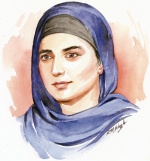Template:AOW5: Difference between revisions
Hari singh (talk | contribs) mNo edit summary |
Hari singh (talk | contribs) No edit summary |
||
| (6 intermediate revisions by the same user not shown) | |||
| Line 1: | Line 1: | ||
[[Image:Sikh lady.jpg | {{aowh|[[Women in Sikhism]]}} | ||
{{pm|Image:Sikh lady.jpg|Water painting of a [[Sikh]] [[woman]] in [[Dastar]] ([[Turban]])}} | |||
In [[Sikhism]], the [[holy scriptures]] have clearly stated that the [[Sikh Women|Sikh woman]] must always be regarded as an equal with man and has all the rights and privileges enjoyed by a man. | |||
[[Sikh]] | She is considered to have the same soul as man and has same right to grow spiritually. | ||
In this faith since about [[1499]], the [[Sikh woman]] is allowed to lead religious congregations, to take part in: | |||
* [[Akhand Path]] (the continuous recitation of the holy scriptures), | |||
* to perform [[kirtan]] – Sikh spiritual hymn singing set to music, | |||
* to work as [[Granthi]] (priest) or preacher and | |||
* to participate freely in all religious, cultural, social, political and secular activities. | |||
[[Sikh]] [[women]] have played a glorious part in [[Sikh history]] and have proven themselves as equal in service, devotion, sacrifice and bravery. Examples of their moral dignity, [[Sewa]] (service) and self sacrifice are and will remain an ever-lasting source of inspiration for all the peoples of the world. | |||
Women are the backbone of the history of the Sikhs; their culture, their values and their traditions - yet there is little written about the huge contribution by the Sikh women to the great history of this religion. {{aowf|Women in Sikhism}} | |||
Latest revision as of 22:43, 12 February 2012
In Sikhism, the holy scriptures have clearly stated that the Sikh woman must always be regarded as an equal with man and has all the rights and privileges enjoyed by a man.
She is considered to have the same soul as man and has same right to grow spiritually.
In this faith since about 1499, the Sikh woman is allowed to lead religious congregations, to take part in:
- Akhand Path (the continuous recitation of the holy scriptures),
- to perform kirtan – Sikh spiritual hymn singing set to music,
- to work as Granthi (priest) or preacher and
- to participate freely in all religious, cultural, social, political and secular activities.
Sikh women have played a glorious part in Sikh history and have proven themselves as equal in service, devotion, sacrifice and bravery. Examples of their moral dignity, Sewa (service) and self sacrifice are and will remain an ever-lasting source of inspiration for all the peoples of the world.
Women are the backbone of the history of the Sikhs; their culture, their values and their traditions - yet there is little written about the huge contribution by the Sikh women to the great history of this religion. .....More

